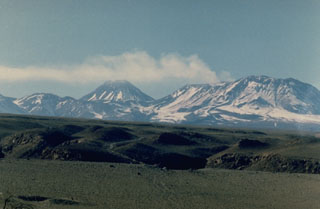Report on Lascar (Chile) — 23 August-29 August 2006
Smithsonian Institution / US Geological Survey
Weekly Volcanic Activity Report, 23 August-29 August 2006
Managing Editor: Sally Sennert.
Please cite this report as:
Global Volcanism Program, 2006. Report on Lascar (Chile) (Sennert, S, ed.). Weekly Volcanic Activity Report, 23 August-29 August 2006. Smithsonian Institution and US Geological Survey.
Lascar
Chile
23.37°S, 67.73°W; summit elev. 5592 m
All times are local (unless otherwise noted)
Several small phreatic explosions occurred at Lascar during May, July, and August. The explosions were separated in time by up to several weeks. The last observed explosion, lasting for about five minutes on 14 August, produced a plume that reached a height of 450 m above the crater (19,800 ft a.s.l.) and dispersed ESE.
Geological Summary. Láscar is the most active volcano of the northern Chilean Andes. The andesitic-to-dacitic stratovolcano contains six overlapping summit craters. Prominent lava flows descend its NW flanks. An older, higher stratovolcano 5 km E, Volcán Aguas Calientes, displays a well-developed summit crater and a probable Holocene lava flow near its summit (de Silva and Francis, 1991). Láscar consists of two major edifices; activity began at the eastern volcano and then shifted to the western cone. The largest eruption took place about 26,500 years ago, and following the eruption of the Tumbres scoria flow about 9000 years ago, activity shifted back to the eastern edifice, where three overlapping craters were formed. Frequent small-to-moderate explosive eruptions have been recorded since the mid-19th century, along with periodic larger eruptions that produced ashfall hundreds of kilometers away. The largest historical eruption took place in 1993, producing pyroclastic flows to 8.5 km NW of the summit and ashfall in Buenos Aires.
Source: Jorge Clavero-Chilean Geological Survey (Sernageomin) and Juan Cayupi-Chilean Emergency Office (ONEMI) via the Volcano Listserv

